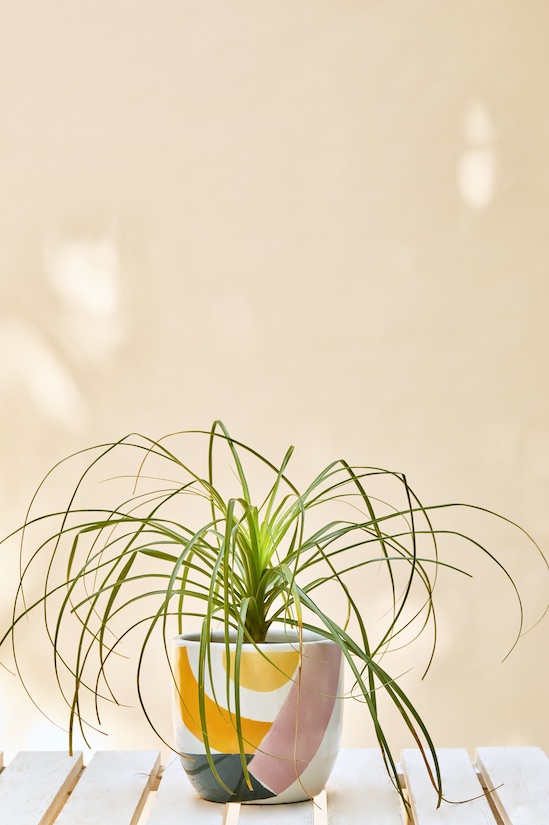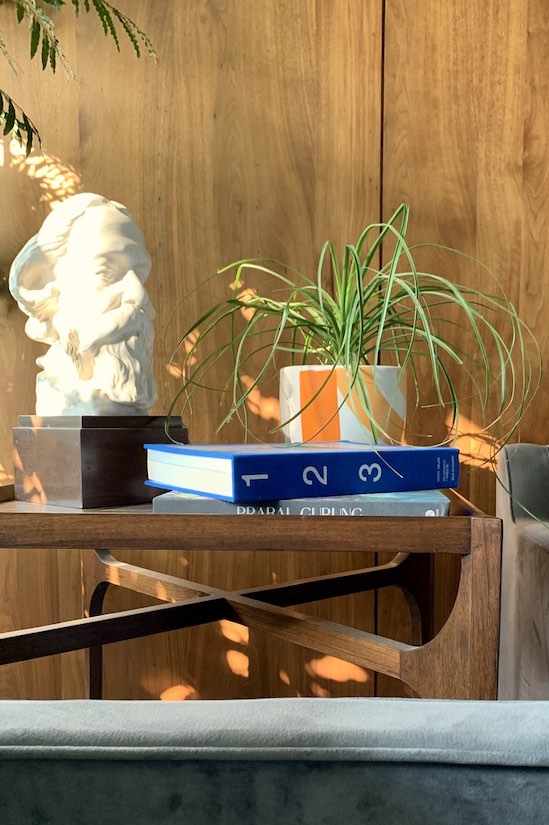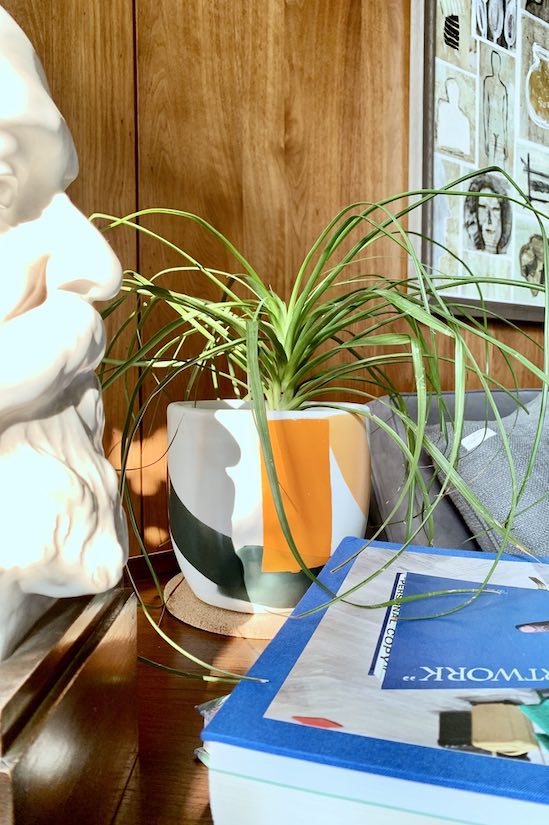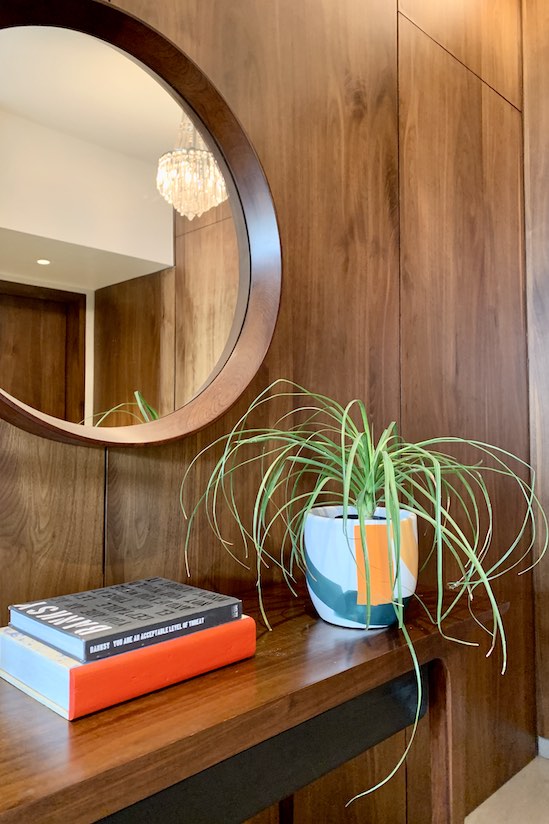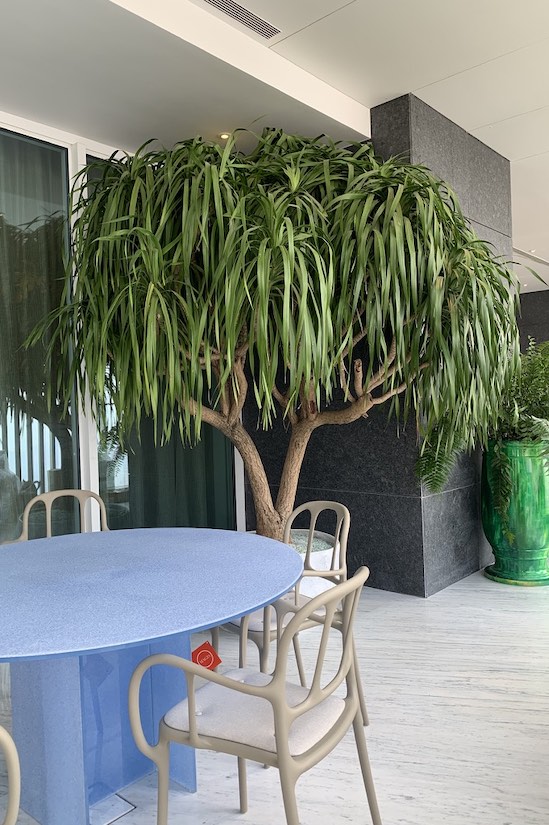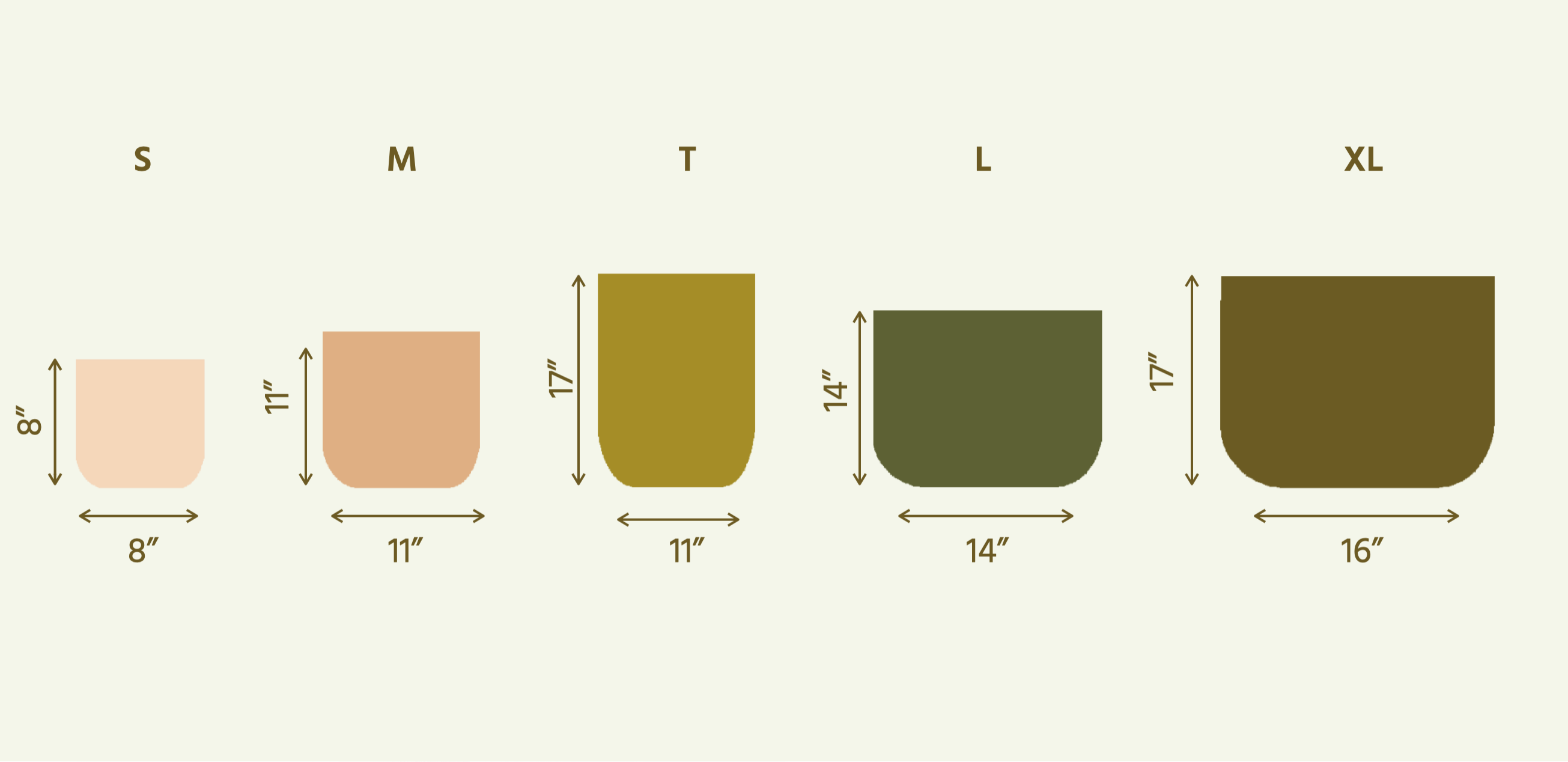Black 14"
₹ 4,250
Everybody's favourite. The Yucatan Nolina from Eastern Mexico has a whole fiesta vibe going for it. It's often called a Ponytail Palm for its spunky hairdo. It's actually not a palm but a semi-desert plant. It's very forgiving and low maintenance. In short, a perfect house plant.
Sunlight:
Texture: Art Deco
Size: 1 Foot
- S
- M
-
Description
Everybody's favourite. The Yucatan Nolina from Eastern Mexico has a whole fiesta vibe going for it. It's often called a Ponytail Palm for its spunky hairdo. It's actually not a palm but a semi-desert plant. It's very forgiving and low maintenance. In short, a perfect house plant.
-
Size details
Base: 8" x 8"
Perfectly sized for the centre of a dining table or a coffee table.Size guide
-
Material description
There’s something special about handmade pottery. A ceramic pot is created by moulding clay into a shape and subsequently heating it at high temperature. Our ceramics are made by artisans in northern Gujarat. We use local wild clay that is as minimally processed as possible. This ancient craft combines the beauty of art, science and imagination to bring warmth integral to contemporary urban decor. One of those things that’s better in real life.
-
Material description
There’s something special about the perfectly-imperfect nature of ceramics. The raw touch, the way the light comes through and that it’s made from the earth all make a ceramic base more than a container.
After decades of using impersonal industrial products, clay, artisans and local manufacturing is making a comeback in interior decor.
Our ceramics are handmade by an artist in northern Gujarat using wild clay that is as minimally processed as possible. This art form is thousands of years old and allows us to go back to a simpler time. A material that is sustainable and low-polluting, clay gives us the relaxed warmth we’re craving. -
Material description
Ceramic
-
Material description
There’s something special about the perfectly-imperfect nature of ceramics. The raw touch, the way the light comes through and that it’s made from the earth all make a ceramic base more than a container.
After decades of using impersonal industrial products, clay, artisans and local manufacturing is making a comeback in interior decor.
Our ceramics are handmade by an artist in northern Gujarat using wild clay that is as minimally processed as possible. This art form is thousands of years old and allows us to go back to a simpler time. A material that is sustainable and low-polluting, clay gives us the relaxed warmth we’re craving. -
Material details
There’s something special about the perfectly-imperfect nature of ceramics. The raw touch, the way the light comes through and that it’s made from the earth all make a ceramic base more than a container.
After decades of using impersonal industrial products, clay, artisans and local manufacturing is making a comeback in interior decor.
Our ceramics are handmade by an artist in northern Gujarat using wild clay that is as minimally processed as possible. This art form is thousands of years old and allows us to go back to a simpler time. A material that is sustainable and low-polluting, clay gives us the relaxed warmth we’re craving. -
Material details
There’s something special about the perfectly-imperfect nature of ceramics. The raw touch, the way the light comes through and that it’s made from the earth all make a ceramic base more than a container.
After decades of using impersonal industrial products, clay, artisans and local manufacturing is making a comeback in interior decor.
Our ceramics are handmade by an artist in northern Gujarat using wild clay that is as minimally processed as possible. This art form is thousands of years old and allows us to go back to a simpler time. A material that is sustainable and low-polluting, clay gives us the relaxed warmth we’re craving. -
Style tip
There’s something special about the perfectly-imperfect nature of ceramics. The raw touch, the way the light comes through and that it’s made from the earth all make a ceramic base more than a container.
After decades of using impersonal industrial products, clay, artisans and local manufacturing is making a comeback in interior decor.
Our ceramics are handmade by an artist in northern Gujarat using wild clay that is as minimally processed as possible. This art form is thousands of years old and allows us to go back to a simpler time. A material that is sustainable and low-polluting, clay gives us the relaxed warmth we’re craving. -
Material details
Dream material. Cork is great looking and nice to touch. It's also fireproof, water resistant and lighter than water, so it's easy to transport. The raw material is derived from the outer bark of the quercus suber tree, commonly known as the cork oak. Once sheared, the bark grows back quickly, making this material a sustainable alternative to plastic. It doesn’t require cutting the tree down – it’s just skinning it. Today it’s experiencing a resurgence in design and architecture due to the fact that it’s recyclable and carbon negative and brings contemporary glamour wherever it’s placed.
-
Material details
There’s something special about the perfectly-imperfect nature of ceramics. The raw touch, the way the light comes through and that it’s made from the earth all make a ceramic base more than a container.
After decades of using impersonal industrial products, clay, artisans and local manufacturing is making a comeback in interior decor.
Our ceramics are handmade by an artist in northern Gujarat using wild clay that is as minimally processed as possible. This art form is thousands of years old and allows us to go back to a simpler time. A material that is sustainable and low-polluting, clay gives us the relaxed warmth we’re craving. -
Care details
The Phoenix Palm is a sunny sort and likes a bright spot in the house next to a window or on a window sill. It loves an outdoor space like a balcony or terrace. But it’s a very forgiving plant so even if you place it in a shady spot it will be fine but maybe wouldn’t thrive as it should.
It’s actually a succulent and needs very little water. Once a week should do the trick. Allow the leaves to be your guide, yellowing or browning tips mean you’re watering too much.
It's a survivor and is usually problem-free. If it isn't doing well, most likely you're over-watering. -
Style tip
Add pebbles for extra glam.
-
Care details
The Phoenix Palm is a sunny sort and likes a bright spot in the house next to a window or on a window sill. It loves an outdoor space like a balcony or terrace. But it’s a very forgiving plant so even if you place it in a shady spot it will be fine but maybe wouldn’t thrive as it should.
It’s actually a succulent and needs very little water. Once a week should do the trick. Allow the leaves to be your guide, yellowing or browning tips mean you’re watering too much.
It's a survivor and is usually problem-free. If it isn't doing well, most likely you're over-watering. -
Material details
There’s something special about the perfectly-imperfect nature of ceramics. The raw touch, the way the light comes through and that it’s made from the earth all make a ceramic base more than a container.
After decades of using impersonal industrial products, clay, artisans and local manufacturing is making a comeback in interior decor.
Our ceramics are handmade by an artist in northern Gujarat using wild clay that is as minimally processed as possible. This art form is thousands of years old and allows us to go back to a simpler time. A material that is sustainable and low-polluting, clay gives us the relaxed warmth we’re craving. -
Care details
The Phoenix Palm is a sunny sort and likes a bright spot in the house next to a window or on a window sill. It loves an outdoor space like a balcony or terrace. But it’s a very forgiving plant so even if you place it in a shady spot it will be fine but maybe wouldn’t thrive as it should.
It’s actually a succulent and needs very little water. Once a week should do the trick. Allow the leaves to be your guide, yellowing or browning tips mean you’re watering too much.
It's a survivor and is usually problem-free. If it isn't doing well, most likely you're over-watering. -
Style tip
Add pebbles for extra glam.
-
Care details
The Phoenix Palm is a sunny sort and likes a bright spot in the house next to a window or on a window sill. It loves an outdoor space like a balcony or terrace. But it’s a very forgiving plant so even if you place it in a shady spot it will be fine but maybe wouldn’t thrive as it should.
It’s actually a succulent and needs very little water. Once a week should do the trick. Allow the leaves to be your guide, yellowing or browning tips mean you’re watering too much.
It's a survivor and is usually problem-free. If it isn't doing well, most likely you're over-watering. -
Style tip
Add pebbles for extra glam.
-
Care details
The Phoenix Palm is a sunny sort and likes a bright spot in the house next to a window or on a window sill. It loves an outdoor space like a balcony or terrace. But it’s a very forgiving plant so even if you place it in a shady spot it will be fine but maybe wouldn’t thrive as it should.
It’s actually a succulent and needs very little water. Once a week should do the trick. Allow the leaves to be your guide, yellowing or browning tips mean you’re watering too much.
It's a survivor and is usually problem-free. If it isn't doing well, most likely you're over-watering. -
Style tip
Add pebbles for extra glam.
-
Care details
The Nolina Palm is a sunny sort and would love a bright spot next to a window or an outdoor space. But it’s very forgiving plant and will make do anywhere you place it (but perhaps won’t thrive to its best potential).
It’s actually a succulent and needs very little water. Once a week should do the trick. Allow the leaves to be your guide, yellowing or browning tips mean you’re watering too much.
It's a survivor and usually problem-free. If it isn't doing well, most likely you're over-watering. -
Style tip
Add pebbles for extra glam.
-
Material details
There’s something special about the perfectly-imperfect nature of ceramics. The raw touch, the way the light comes through and that it’s made from the earth all make a ceramic base more than a container.
After decades of using impersonal industrial products, clay, artisans and local manufacturing is making a comeback in interior decor.
Our ceramics are handmade by an artist in northern Gujarat using wild clay that is as minimally processed as possible. This art form is thousands of years old and allows us to go back to a simpler time. A material that is sustainable and low-polluting, clay gives us the relaxed warmth we’re craving. -
Care details
The Nolina Palm is a sunny sort and would love a bright spot next to a window or an outdoor space. But it’s very forgiving plant and will make do anywhere you place it (but perhaps won’t thrive to its best potential).
It’s actually a succulent and needs very little water. Once a week should do the trick. Allow the leaves to be your guide, yellowing or browning tips mean you’re watering too much.
It's a survivor and usually problem-free. If it isn't doing well, most likely you're over-watering. -
Care details
The Phoenix Palm is a sunny sort and likes a bright spot in the house next to a window or on a window sill. It loves an outdoor space like a balcony or terrace. But it’s a very forgiving plant so even if you place it in a shady spot it will be fine but maybe wouldn’t thrive as it should.
It’s actually a succulent and needs very little water. Once a week should do the trick. Allow the leaves to be your guide, yellowing or browning tips mean you’re watering too much.
It's a survivor and is usually problem-free. If it isn't doing well, most likely you're over-watering. -
Material details
There’s something special about the perfectly-imperfect nature of ceramics. The raw touch, the way the light comes through and that it’s made from the earth all make a ceramic base more than a container.
After decades of using impersonal industrial products, clay, artisans and local manufacturing is making a comeback in interior decor.
Our ceramics are handmade by an artist in northern Gujarat using wild clay that is as minimally processed as possible. This art form is thousands of years old and allows us to go back to a simpler time. A material that is sustainable and low-polluting, clay gives us the relaxed warmth we’re craving.




